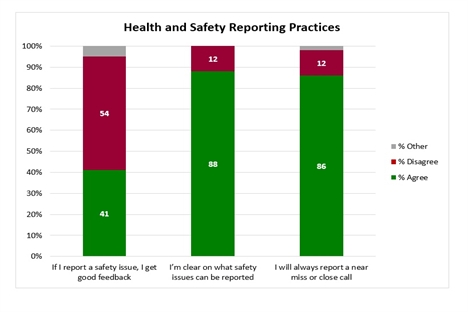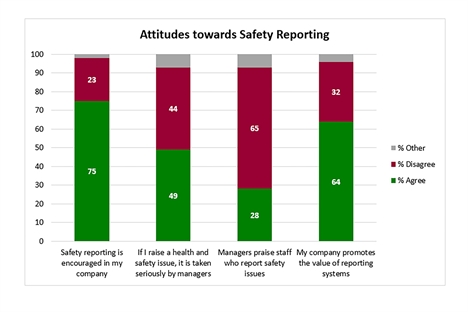21.03.17
Collecting safety culture data confidentially
Source: RTM Feb/Mar 17
Chris Langer, scheme intelligence manager at CIRAS, explains how confidential reporting can ‘deep dive’ into an organisation’s safety and reporting culture to reveal what might be happening far beneath the surface, often hidden from senior management.
For about a year now, CIRAS has been asking reporters who call in with their health and safety concerns an additional set of questions about their perceptions of the safety and reporting culture they work in. Uniquely perhaps, they are free to respond to these questions totally honestly, without the fear of any repercussions. It is worth emphasising here that callers can always talk confidentially over the phone to CIRAS in a completely uncensored way. The responses gained in these interviews are anonymised and untraceable, providing insights into safety and reporting culture as seen through the eyes of employees who live and breathe the reality at the coalface.
This is all part of CIRAS’s proactive strategy to capitalise on a key selling point of the scheme in surfacing hidden intelligence. This strategy fits neatly with the radical and innovative ideas on safety culture presented by human factors expert Erik Hollnagel.
Hollnagel’s book, ‘Safety Culture-I and Safety Culture-II: The Past and Future of Safety Management’, describes his approach with an eye to overhauling traditional safety management thinking in favour of a fresh way of working. Safety-I and Safety-II basically represent different philosophies of safety culture. In Safety-I, safety management is reactive: the goal is to achieve the lowest possible number of events going wrong. Safety-II is more focused on being proactive: it looks at where and how things are going right and is far more accepting of the variability in human performance.
Confidential reporting is firmly aligned with the Safety-II philosophy. Confidential reports and the intelligence surfaced about safety and reporting culture at the time of interview play an important role in helping managers take a proactive stance towards emergent risks. If we want to shift a safety culture from a reactive to proactive mindset, we first need to ascertain how a given culture is perceived by the employees who actually experience it on a daily basis. This is where the new CIRAS data may be able to provide an important indicator of the health of the underlying culture.
The responses to the questions asked in CIRAS interviews presented overleaf make for an interesting read. They are based on a sample of 227 and include responses gained from a variety of transport bodies: Network Rail, London Underground, suppliers/contractors and TfL bus operators.
There may be a concern that these results could be distorted because they are solely from employees who already feel their safety concerns remain unaddressed. However, it is likely that a similar pattern of findings would emerge from a sample population of employees who have not previously reported to CIRAS. The differences between the responses given by reporters to CIRAS and the workforce in general tend to be overstated. At any rate, this is a view that can be tested in reality by surveying non-CIRAS reporting employees – we plan to do this in due course. We may in fact find that the data presented here, even with its imperfections, is actually more representative than might initially be assumed. To use an appropriate metaphor, if we slice a tree trunk open, the pattern of rings normally runs unimpeded right through the trunk.


What is the data telling us?
The information in the bar charts provides some valuable insights into safety and reporting culture across a variety of transport sectors. At this aggregate level, it is not clear if some transport sectors are viewed more favourably in terms of safety and reporting culture by CIRAS reporters. However, this kind of analysis could easily be carried out in future – it would no doubt make for some interesting reading. Are there sectors, for example, where perceptions of the prevailing health and safety culture are noticeably higher? And what could we learn from any positive examples which could be applied elsewhere?
What is clear, though, is that the overwhelming majority of reporters (88%) in our sample are clear on what issues they can report, and 86% say they will always report a near miss or close call; half the battle has been won at least. This suggests that spending additional money on educating employees on what issues to report, and how to report, may only provide a marginal benefit. Employees appear to be well versed on what to do.
Reporters are far less confident in the feedback they will gain if they do raise a report internally – only 41% answer this question positively. And although the vast majority of reporters (75%) say their organisations encourage safety reporting, and promote the value of reporting systems in general, far fewer (49%) are satisfied that health and safety issues are taken seriously by managers. Fewer still (28%) say managers praise staff who report safety issues. Providing timely, quality feedback for health and safety issues raised internally by staff is an area that many organisations may be able to improve on.
What we need to be able to elaborate on in future is why perceptions exist that health and safety issues are not being taken seriously. What we know already is that in up to 20% of CIRAS cases, no feedback to a health and safety issue raised is provided. This feedback ‘loophole’ should in theory be possible to close with a credible report tracking system.
If nothing else, these findings really underline how important it is to collect data on the perceptions of safety and reporting culture. A CIRAS report does not simply show up in a contextual vacuum, but is the product of a culture which is in itself worthy of investigation.
FOR MORE INFORMATION
W: CIRAS.org.uk
Tell us what you think – have your say below or email [email protected]